Will Star Goddess Astraea Return To Earth With Second Golden Age Or Apocalypse?
A. Sutherland - AncientPages.com - According to ancient Greek myth, the goddess Astraea was the last of the immortals to leave our planet with the decline of the ages.
Her return one day would signal the advent of a new epoch. Will she return with the Second Golden Age?
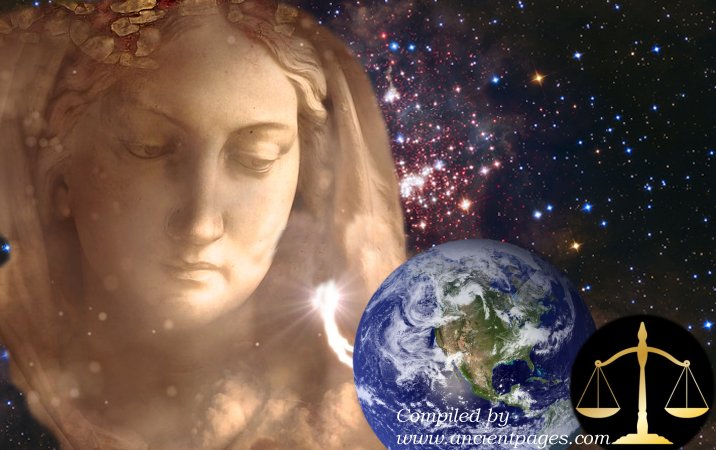
Astraea, dubbed "the starry one," was the virgin goddess who carried the rays of Zeus in her arms. She was the daughter of Zeus and Themis, or according to sources, of Eos, a Titaness and the goddess of the dawn, and Astraeus, the god of starlight and astrology, who in Greek mythology was one of Titans.
Astraea is also associated with the Latin Justitia - a goddess and a symbol of justice. She is also a highly valued symbol of innocence and purity.
The celestial virgin Astraea, who has long been associated with both renewal and rebirth, left the Earth and was the last of the immortal goddesses, living among people during the Golden Age, which in ancient Greek beliefs was an extraordinary period of peace, prosperity, ideal harmony, and stability.
During this age, no one was hungry, yet people did not have to work to feed themselves because our planet delivered abundant food.
Human Races Lived During Golden, Silver, Bronze, Heroic, and Iron Age
Many of us know that different races lived during the Golden, Silver, Bronze, Heroic, and Iron Ages.
For example, Greek mythology tells how each human race created by the gods was less advanced than the previous one.
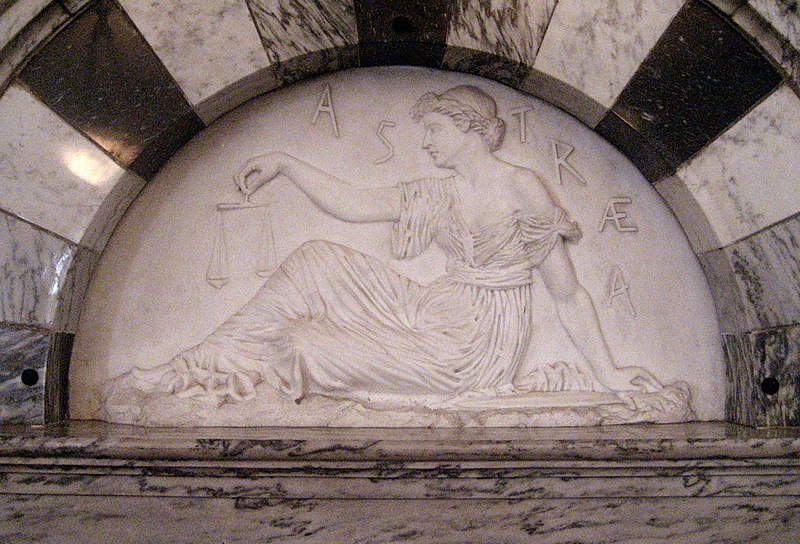
1886 sculpture of Astræa, signed "A," possibly the work of August St. Gaudens. Old Supreme Court Chamber, the Vermont State House, Montpelir, Vermont. August 2007. Source
Cronus, the father of Zeus, created the Golden Age, and during this beautiful time, the first humans (Golden Race) lived in prosperity and peace. When this race was destroyed, Zeus, like his father, had to create the Silver Age and its people, but the climate on Earth changed and made life for the Silver Race less comfortable. Cold winters forced them to seek shelter in caves.
Zeus's next attempt was to create a new race, the Bronze Race. These people were skilled metallurgists and lived in houses made of metal, but being far from peaceful, they participated in devastating wars. After them, there was yet another race of mighty demi-gods and brave heroes, and they lived in the Heroic Age. After that, the Iron Race was created, and this epoch continues.
In the troublesome Iron Age, the gods abandoned humans and left, and only the goddess Astraea remained on the ground, but not for long. She did not want to live among humans. Depressed by the people's crimes and wickedness, greed, and violence, she did not want to confront evil anymore and decided to return to the sky.
Goddess Astraea And The Virgo Constellation
According to Ovid (43 BC – 18 AD), a Roman poet who lived during the reign of Augustus, this noble goddess left the planet Earth and ascended to the heavenly realm. One version of her story says she was moved to the stars by her father. There, she became the constellation Virgo, the sixth sign of the zodiac. She is usually depicted as a young woman with wings and a scale in one hand.
Virgo constellation. Credit: Adobe Stock - inga
She has wings and a shining halo over her head; on the other hand, she holds the stars or rays of Zeus. In some way, Astraea - holding the scales of justice for weighing our deeds - still has us waiting and observing our planet.
The Return Of Goddess Astraea
One legend says that when the troubled period for humanity ends, the beautiful goddess Astraea will be back, bringing the Second Golden Age with her.
Titan Cronus supervised the Golden Age in classical Greek mythology, and Astraea was the ambassador. However, we have only scarce written sources about her.
Scholars and especially poets have interpreted her existence in several ways. To some, this goddess had a deep spiritual meaning. Others associated her with a future doomsday prophecy, or her return to Earth was also equated with re-creation or the return of the Golden Age.
Generally, it is difficult to describe the goddess Astraea's mythological importance. Still, she can be understood as a mysterious pagan who conceals and reveals universal truth, or she might represent divine wisdom, inspiring humankind through troubles to a brighter future.
Although Christianity replaced the cyclic with a linear theory of history, it still talks about the final return - Christ's coming and the universe's renewal.
In both the pagan and the Christian understanding of history, the goddess Astraea can symbolize paradise when she shows herself again to man.
People worldwide have been waiting for this moment for a long time. In this sense, the return of Astraea can be regarded as human longing for the perfection of beginnings filled with harmony, peace, and prosperity.
Many believe that Astraea has never abandoned us humans, but she is waiting in the heavens for the moment of return.
Will Astraea bring the golden age for us, or let us confront the apocalyptic vision?
Written by – A. Sutherland AncientPages.com Senior Staff Writer
Updated on January 7, 2024
Copyright © AncientPages.com All rights reserved. This material may not be published, broadcast, rewritten or redistributed in whole or part without the express written permission of AncientPages.com
More From Ancient Pages
-
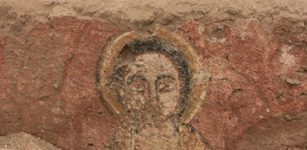 1,000-Year-Old Paintings Unearthed In Sudan – Documented By The Polish Researcher
Archaeology | Sep 25, 2022
1,000-Year-Old Paintings Unearthed In Sudan – Documented By The Polish Researcher
Archaeology | Sep 25, 2022 -
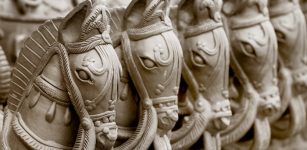 Legendary Uchchaihshravas: Divine Seven-Headed Flying Horse Of God Indra
Featured Stories | May 1, 2017
Legendary Uchchaihshravas: Divine Seven-Headed Flying Horse Of God Indra
Featured Stories | May 1, 2017 -
 Secret Passageways And Caves Beneath UK’s City Of Nottingham
Featured Stories | Feb 14, 2023
Secret Passageways And Caves Beneath UK’s City Of Nottingham
Featured Stories | Feb 14, 2023 -
 ‘Green’ Saudi Arabia Was Home To A 350,000-Year-Old Human Settlement
Archaeology | May 18, 2021
‘Green’ Saudi Arabia Was Home To A 350,000-Year-Old Human Settlement
Archaeology | May 18, 2021 -
 What Caused The Unexplained Change In Europeans’ DNA 4000-5000 Years Ago? Scientists Say The Genetic Turnover Remains A Mystery
Archaeology | Aug 27, 2014
What Caused The Unexplained Change In Europeans’ DNA 4000-5000 Years Ago? Scientists Say The Genetic Turnover Remains A Mystery
Archaeology | Aug 27, 2014 -
 Daily Life Of A Lady In Waiting – A Dangerous Profession Sometimes
Ancient History Facts | Aug 24, 2023
Daily Life Of A Lady In Waiting – A Dangerous Profession Sometimes
Ancient History Facts | Aug 24, 2023 -
 Lesicheri Obelisk – Enigmatic Ancient Roman Structure – Bulgaria’s Tallest Surviving Landmark
Featured Stories | Jan 24, 2023
Lesicheri Obelisk – Enigmatic Ancient Roman Structure – Bulgaria’s Tallest Surviving Landmark
Featured Stories | Jan 24, 2023 -
 Earliest Systematic Coal Exploitation For Fuel Goes Back To ~3600 B.P.
Archaeoastronomy | Aug 2, 2023
Earliest Systematic Coal Exploitation For Fuel Goes Back To ~3600 B.P.
Archaeoastronomy | Aug 2, 2023 -
 Human Migration Out Of Africa To Middle East Through Corridors Provided By Monsoons
Archaeology | Nov 27, 2019
Human Migration Out Of Africa To Middle East Through Corridors Provided By Monsoons
Archaeology | Nov 27, 2019 -
 Ancient Romans Invented The First Bound Book
Ancient History Facts | Sep 25, 2017
Ancient Romans Invented The First Bound Book
Ancient History Facts | Sep 25, 2017 -
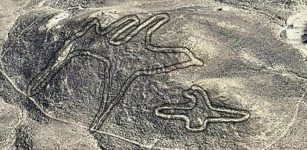 Nasca Lines: Researchers Identify 16 Bird Geoglyphs Drawn On Desert Plains Of Peru
Archaeology | Jun 23, 2019
Nasca Lines: Researchers Identify 16 Bird Geoglyphs Drawn On Desert Plains Of Peru
Archaeology | Jun 23, 2019 -
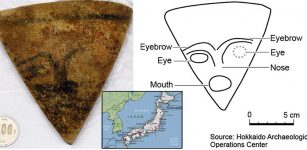 Jomon Period: Triangle-Shaped Stone Artifact Depicting Human Face Found For The First Time In Japan
Archaeology | Dec 25, 2017
Jomon Period: Triangle-Shaped Stone Artifact Depicting Human Face Found For The First Time In Japan
Archaeology | Dec 25, 2017 -
 Spectacular Square-Headed Creature And 143 New Nazca Geoglyphs – Discovered
Archaeology | Nov 19, 2019
Spectacular Square-Headed Creature And 143 New Nazca Geoglyphs – Discovered
Archaeology | Nov 19, 2019 -
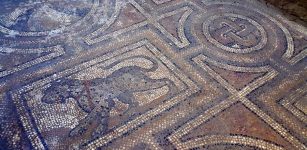 Ruins Of A Roman-Era Bath And A Floor Mosaic Discovered In Central Anatolia
Archaeology | Dec 28, 2015
Ruins Of A Roman-Era Bath And A Floor Mosaic Discovered In Central Anatolia
Archaeology | Dec 28, 2015 -
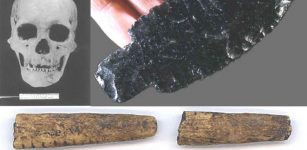 Buhl Woman Of Idaho: One Of The Oldest Skeletons In North America
Civilizations | Jun 3, 2023
Buhl Woman Of Idaho: One Of The Oldest Skeletons In North America
Civilizations | Jun 3, 2023 -
 Hidden 2,000-Year-Old Roman Road Uncovered In Worcestershire Could Be Of ‘Global Importance’
Archaeology | Nov 12, 2022
Hidden 2,000-Year-Old Roman Road Uncovered In Worcestershire Could Be Of ‘Global Importance’
Archaeology | Nov 12, 2022 -
 Ancient Script Reveals Mysterious Location Of Legendary Hanging Garden Of Babylon
Featured Stories | Apr 4, 2014
Ancient Script Reveals Mysterious Location Of Legendary Hanging Garden Of Babylon
Featured Stories | Apr 4, 2014 -
 On This Day In History: Ensisheim Meteorite Fell To Earth – On Nov 7, 1492
News | Nov 7, 2016
On This Day In History: Ensisheim Meteorite Fell To Earth – On Nov 7, 1492
News | Nov 7, 2016 -
 Vikings Had Dark Humor And Joked Even During Deadly Battles
Vikings | Aug 20, 2024
Vikings Had Dark Humor And Joked Even During Deadly Battles
Vikings | Aug 20, 2024 -
 Remains Of 2,500-Year-Old Aphrodite Temple Unearthed In Turkey
Archaeology | Jan 7, 2021
Remains Of 2,500-Year-Old Aphrodite Temple Unearthed In Turkey
Archaeology | Jan 7, 2021

